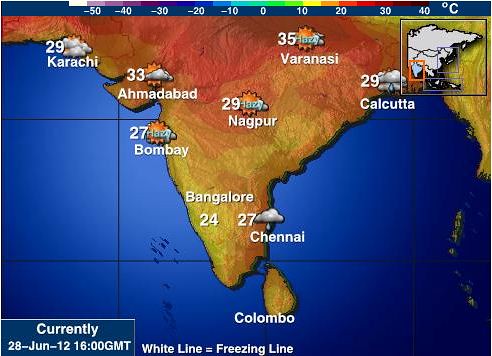On any given day, if you use your favorite web browser to search for climate news, there would be countless articles that appear. These talk about changes in temperature and what countries are doing to mitigate climate change. Similarly, if you search for weather news, another countless number of articles result, such as flooding, tornadoes or a heat wave. They’re both talking about conditions of the atmosphere at a given location. But what really is the difference?
Weather is the condition of the atmosphere over a short period of time. A short period of time can be as short as 5 minutes in relation to a thunderstorm, to a week or even longer when experiencing a tropical cyclone. Weather is always changing, and it’s what you look to when you’re planning outside activities and what to wear.

Current Weather conditions in India on 28 June 2012, from intellicast.com
The GLOBE Program focuses on the collection of weather data through its atmosphere protocols. These include, but are not limited to, air temperature, precipitation, relative humidity and clouds. Data from these protocols that are entered into the GLOBE database are very important to building a long term record. As the record length increases, GLOBE schools will be able to study climate using GLOBE data.
Climate is the condition of the atmosphere over a long period of time. A long period of time is generally defined as 30 years or longer by the World Meteorological Organization (WMO). In order to determine a location’s climate, statistics are performed with the major atmospheric variables listed above. These statistics take into account the latitude, terrain, altitude and proximity to water of a location.
As the GLOBE Program matures, GLOBE schools and scientists will be able to use data entered into the GLOBE database to examine changes in climate over time. For example, if your school keeps a continuous air temperature record for 30 years at the same atmosphere site, you would be able to calculate the normal temperature for your specific school. A normal temperature is the temperature of a location calculated by taking the daily temperature and averaging it over 30 years.
An easy way to think about the difference between weather and climate is to think about your clothes closet. Each day, you get up and choose an outfit, such as a school or work uniform. That’s weather. However, when you look at your wardrobe as a whole, you’re looking at climate. As another example, take a look at this video from grist.com explaining variations (weather) and trends (climate) using a dog and his owner on a walk:
Understanding the difference between weather and climate is a key outcome of the GLOBE Student Climate Research Campaign (SCRC). It aims to engage students in measuring, investigating, and understanding the climate system in their local community as well as around the world. Using GLOBE protocols and data, as well as other long-term datasets, students take climate-related measurements and investigate research questions about climate. Are you a school participating in the SCRC? We’d love to hear from you! Leave us a comment or email us at science@globe.gov.
-Jessica Mackaro

I’m not participating in the SCRC but I loved your explanation here to distinguish weather and climate. TBH it has always been a little fuzzy to me and your clothes/wardrobe analogy made it click! Someone had to speak to me in my language I guess… =)